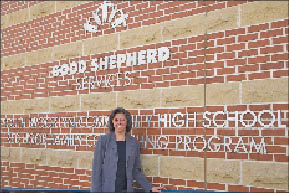 |
|
Henriquez-McArdle has helped South Brooklyn Community High School evolve into a model for curtailing dropouts. Photo: Nura Qureshi |
Brooklyn, N.Y.—For four years, Vanda Belusic and Millie Henriquez-McArdle have worked together on a mission to graduate would-be dropouts at South Brooklyn Community High School. They work in such harmony that they finish each
other’s sentences. They claim to have disagreements but never tension.
What’s really rare about their relationship, however, is that they share power – even though Belusic is the school principal, and Henriquez-McArdle is an administrator from a local nonprofit, Good Shepherd Social Services, which made its mark in foster care but has been working in public schools for more than 30 years.
The two women, sitting in a high school in a neighborhood of weathered rooftops near the Brooklyn waterfront, form a partnership in youth work that is not only unusual, but that city officials hope becomes a model for stopping kids from dropping out.
The city is borrowing from that formula to create a new approach to reach at-risk kids: Yoke together school and nonprofit partners with a unified mission to get diplomas in the hands of youth most at risk of dropping out. The partners will sink or swim together, based on that goal.
The partnership is as high-level as a community-based organization (CBO) could hope to reach within the public school infrastructure: a seat at the head of the table, with substantial city finances and support for the work it plans to do, as opposed to a more common, non-mandatory arrangement, such as a principal contracting for services from the CBO.
The model cuts against history, both here and elsewhere. CBOs have had a relatively small role in the New York City public schools, according to Peter Kleinbard, president of the Youth Development Institute, based at the Fund for the City of New York.
“This is a whole different level of involvement,” Kleinbard says.
The Drop-Out Path
Perhaps nowhere is the challenge of stemming dropouts larger than in New York. Every day, more than 1 million youths walk or take subways and public buses to schools. Nearly 70,000 youths don’t go at all (they’ve dropped out), while another 70,000 don’t go enough – they’re all but destined to slip out of the education system without graduating. The combined population of the latter two groups is larger than the total number of students in any other U.S. city school district, except Los Angeles.
The kids who don’t go enough are labeled OAUC: “over-age and under-credited,” which means they’re ages 16 to 21 and well behind the pace of 11 credits a year they need to graduate.
With a projected job boom in New York, the city Department of Education is desperate to get those youths back on the diploma path. Through its Office of Multiple Pathways to Graduation, the department is looking to community-based organizations to help.
City officials almost stumbled onto the pattern of OAUC youth as they began to open small schools as part of an education reform plan. The Education Department, largely through funding from the Bill and Melinda Gates Foundation, hired the Parthenon Group of Boston to help quantify the size and patterns of the problem, primarily by using the city’s class of 2003 cohort.
The findings were staggering. Among youth who actually dropped out that year, 93 percent were OAUC when they made the decision. Of the youth who hit age 16 with fewer than eight of the 44 credits needed to graduate, nearly 80 percent did not graduate on time.
Those moving toward a future without a diploma will almost certainly be last in line for the thousands of skilled labor jobs expected to become available as the city’s baby boomers retire or move on to other work. For example, an estimated 3,500 health care jobs, 4,000 construction jobs and 600 auto maintenance jobs will open up in the city each year through 2012, according to “Chance of a Lifetime,” a study by the Center for an Urban Future.
The Parthenon report found cause for hope: While a dismal 19 percent of the city’s OAUC youth in regular high schools graduate, those using the city’s alternative education services graduated at more than double that rate. The two main alternative approaches are “transfer schools,” which are full-time day schools that offer more semesters each year to help students accumulate credits at twice the pace of regular schools; and young adult borough centers, which are part-time evening programs that target youth over 17 who are close to graduation.
The Solution
By the time the Parthenon report was released late last year, Michele Cahill had spent two years developing the Learning to Work (LTW) initiative as counselor on education policy for the city. Cahill is well-known in the youth development field: She helped start the Academy for Educational Development’s Center for Youth Development in 1990.
The initiative pays CBOs to combine support services in school with employment training and college preparation. The work includes reaching out to youth who miss days to make sure it doesn’t become a habit, group and individual counseling, a subsidized internship program and job placement services.
LTW is based largely on the past work of South Brooklyn Community High School, which has long provided the kind of support services the city now funds under the program. Good Shepherd established the school in 1980 to help youth who dropped out of nearby John Jay High School. Belusic, then an Education Department instructional specialist, was on the planning team that helped South Brooklyn become its own independent transfer school in 2001, and ultimately became its principal.
The red brick building, located in the mostly low-income Red Hook area of Brooklyn, holds 150 students. Along the bulletin board-filled halls, spaces for counselors to meet with teens are interspersed among the classrooms, many of which are led by young teachers clad in blue jeans.
“It’s a bright, cheery … personalized environment … coupled with very rigorous academics,” says Sister Paulette LoMonaco, Good Shepherd’s executive director.
The city hired JoEllen Lynch, who had headed South Brooklyn for Good Shepherd, to help develop LTW. She now heads the Office of Multiple Pathways to Graduation, where LTW is based.
Spending on LTW programs began at $16 million in 2006, reached $24 million this fiscal year and is expected to be $31.5 million by 2008. The plan is to establish 14 new LTW young adult borough centers (12 are now operating) and 15 new LTW transfer schools (10 are now operating).
The process of developing an LTW transfer school is complicated, but here’s the gist of it:
The Gates Foundation puts up money for intermediaries to get new transfer schools off the ground, seed money for the first three years. Three intermediaries won funding: Good Shepherd and New Visions for Public Schools, both in New York, and Diploma Plus, based in Boston.
The intermediaries contract with a CBO to develop each school, and find a leader from that CBO and a would-be principal, with approval from the Multiple Pathways office.
 |
|
Messages to keep youth focused abound at South Brooklyn. Photo: John Kelly |
The principal works for the Education Department, which oversees development of the school’s plan and the hiring of teachers.
Gradually, the transfer school moves out of the planning phase under Gates funding. Usually, the CBO leader and the principal will continue to run the school. Co-leadership takes the same shape at young adult borough centers, with some administrative differences and without start-up funding by Gates.
The goals for the two leaders are identical: Increase the school’s graduation rate.
The CBOs are largely responsible for attracting students. The city gives the organizations the names of OAUC students at local public schools for possible recruitment. In addition, organizations that provide other social services use those channels to reach potential candidates.
The CBOs are also in charge of the support services, such as outreach to improve attendance.
Other CBOs that help run transfer schools and young adult borough centers under this arrangement include the Federation Employment and Guidance Service, Educators for Children, Youth & Families, and the South Bronx Overall Economic Development Corp.
The Enforcement
While nonprofits around the country are increasingly establishing a presence in running after-school programs in schools, it’s almost unheard of for a public school executive and staff to accept a youth development organization on equal footing.
“The mayor really needs to be commended on this commitment,” says Shane Mulhern, who is leading efforts by New Visions to start up transfer schools with Gates funding. “The question is: How sustained will it be beyond this term?”
Therein lies the challenge for the city. The experience of the youth worker in public school systems is mixed. Get the right principal and welcoming teachers, and it’s kumbaya. With the wrong mix, it’s oil and water.
“Generally, it doesn’t go well,” Henriquez-McArdle says of arrangements between schools and CBOs. “It’s a challenge. There are hardships.”
She and Belusic didn’t walk in step overnight. Nor is it a given that co-leaders under LTW will ever develop the mutual respect that these two have. It’s easy to see that the positive energy between them is not an act.
“There are a lot of schools with LTW grants that are struggling [to develop] the relationship we’ve created,” Henriquez-McArdle says.
How does the city make sure the shared-power vision for these transfer schools and borough centers stays in place? The Multiple Pathways office helps by creating training opportunities for co-leaders, networking channels for continued support, and having a set of requirements and consequences for failure that would equally affect the CBO and Education Department leaders at the sites.
For example, the Education Department’s leadership academy helps to groom future principals, including those the intermediaries have cited as potential candidates for LTW schools. And the Learning to Work Network brings the city’s LTW principals and CBO leaders together once a month.
The shared responsibility for increasing the number of youths graduating from the school helps to foster teamwork between the CBO leader and principal.
“It’s not where [as a CBO] you say, ‘The school is trying to get the student a diploma, and we’re providing services,’ ” Cahill says. “The CBO has to be working towards the diploma, and so does the school, so they have to form an integrated strategy if everyone has to reach the same goal.”
The risk for the CBO is that it could lose the LTW contract, either when the contract expires after five years or due to the closing of a school. Under the Education Department’s accountability measures, says Lynch of the Multiple Pathways office, “there’s a lot of reasons we can cancel a contract.”
As for the principals, they are far less protected than are their tenured brethren in the mainstream schools. They sign contracts that give them more flexibility in obtaining resources for the school, but they face perhaps the most serious consequences of anyone in Multiple Pathways.
Each school under LTW will receive a progress report that is tailored specifically to its target population, as well as a proportional letter grade. The specific transfer school accountability standards will be finalized in September, and will “aim to measure the impact of the transfer school on student achievement, relative to achievement at a [student’s] previous school,” says Leah Hamilton, deputy executive director of Multiple Pathways.
But the consequences for poor performance on progress reports are already clear, according to the standards the city is applying to all of its Empowerment Schools (a larger initiative that includes LTW). If the school receives a D or F, according to those standards, “it will be subject to school improvement measures and target setting.” Further poor performance will result in a change of leadership or even school closure.
Enough Money?
There are plenty of challenges.
Some observers question whether the funding for the organizational partners under LTW will be enough to provide services that approach the likes of South Brooklyn. Mulhern, at New Visions, says the LTW money will probably cover about 75 percent of what a CBO will need.
That means CBOs might have to spend some of their own money on the endeavors. “There’s always been the hope that organizations are committing their own resources, but this is a substantial investment” by the city, Cahill says. “There is no matching requirement” for the CBOs.
But Lynch – the former Good Shepherd leader at South Brooklyn – says, “I think it’s adequate funding. There’s not an expectation” that CBOs would need to raise more money.
The city LTW funding would provide for a 50:1 ratio of transfer school students to “advocate counselors,” as well as one intern placement and one career/college specialist. The ratio at South Brooklyn is 25:1.
The ratio “has to be manageable,” Belusic says. “You can’t do it with a caseload of 50 or 40” youths per counselor. Good Shepherd uses private support to supplement the city funding, she says.
Another issue: The challenge of creating an ongoing strong partnership. Attendance at the LTW Network meetings has been spotty. “The principals don’t all show up for the monthly meetings,” Henriquez-McArdle says, although she also says the city is doing “a lot to address the partnership implementation issues.”
The payoff for success is huge. At South Brooklyn, the graduation rate of about 68 percent stands well above the norm for other transfer schools.
“It’s a powerful combination when it works,” Kleinbard says of the shared leadership concept. “But the notion of partnership is central.”
Contact: Good Shepherd (212) 243-7070, http://www.goodshepherds.org; Office of Multiple Pathways to Graduation (212) 374-6713, http://www.nycboe.net/Offices/DYD/OMP.































